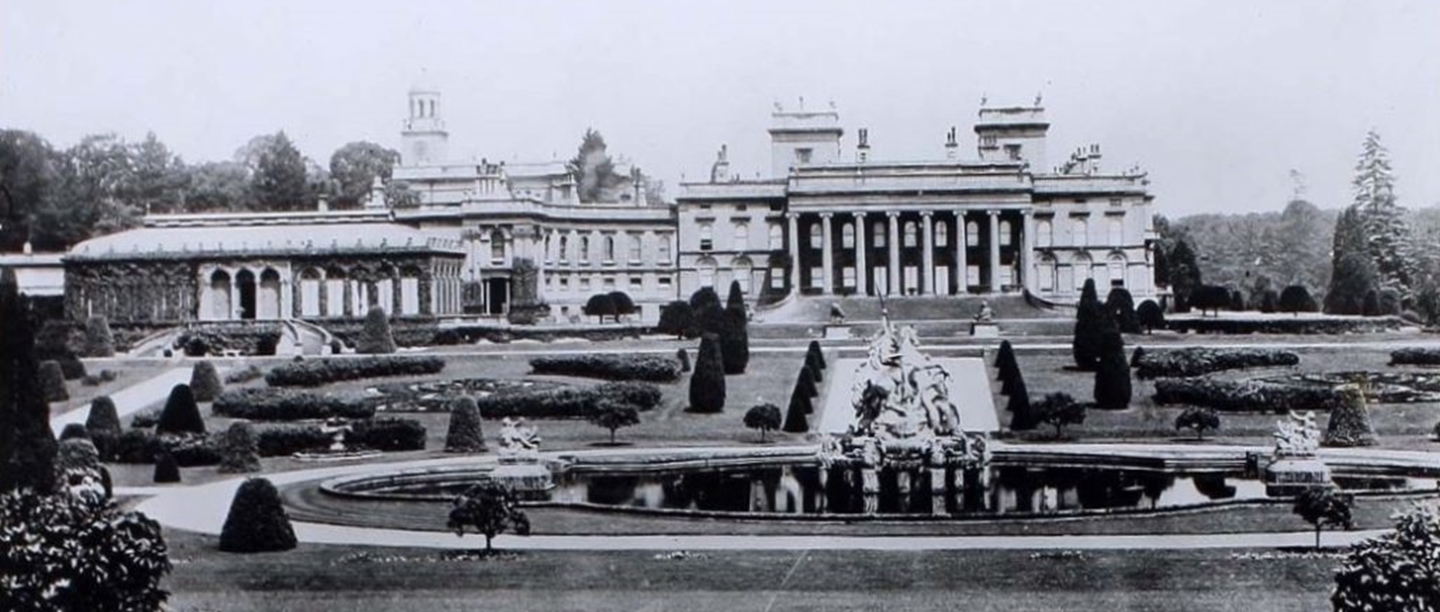
Gardens have always been places for entertaining. The courtyards of Roman villas were used for socialising, eating and relaxing. The Tudors staged pageants and theatrical performances in their gardens. Middle class Georgians flocked to pleasure gardens, and in the age of the country house the upper classes used their estates to host a wide variety of activities, from tea parties and carriage rides to fishing and fireworks.
Our Enchanted events tap into this rich tradition of entertaining in the outdoors. This December, you’re invited to step into a world full of light and colour at - Audley End, Eltham Palace, Brodsworth Hall, Beslay Hall and Witley Court. You can book your tickets now to make sure you don’t miss out.
With the help of Landscape Advisor Emily Parker and Properties Historian Andrew Hann, we’re taking a look at five historic frolics and garden parties that took place at the gardens in our care.
Loud Late Nights at Eltham Palace
Stephen and Virginia Courtauld transformed the run-down remains of Eltham Palace into a house fit for parties. One of the grandest gatherings took place in July 1937 to celebrate the 21st birthday of Peter Peirano, Virginia’s nephew.
The Courtaulds hired royal confectioners Gunter & co. to cater for 450 guests, with music provided by Lew Stone’s dance band – one of the biggest acts in the country at the time. There was a German beer garden, complete with barmen and barmaids in Tyrolean costume. The moat was floodlit, and ‘a daring young man on the flying trapeze’ provided further entertainment.
The highlight of the party was the firework display, which began rather late in the evening. As the Kentish Times reported, ‘when the first rocket went off at midnight to signalise the beginning of the fireworks, there was a rush for the chairs arranged in the garden…the showers of multi-coloured “stars” lit up the lawn’.
The Courtaulds had form when it came to late-night parties that went off with a bang. In the summer months they would often host ‘at homes’, which didn’t start until 10pm. Guests – and neighbours – could expect dancing and fireworks to go on well into the early hours.
In July 1937 a local resident wrote to the Office of Commissioners of Crown Lands (the body that leased Eltham Palace to the Courtaulds), ‘to register a most emphatic protest against the firework display given at Eltham Hall last night, commencing at midnight and continuing until 12.45 a.m.’
He was woken up by the noise and felt it was ‘most disturbing and objectionable’, as did his dog, who ‘was in a state of semi-hysteria for the rest of the night’.
Georgian High Society and Tea Parties at Audley End
Leisure became increasingly commercialised in the 18th century. Theatres, assembly rooms, concert halls, promenades and pleasure gardens opened up in towns and cities across the country to supply a growing demand for public leisure spaces.
At pleasure gardens, rich and poor alike could enjoy gravel walks, music, fountains, fireworks and refreshments. These were places for socialising with friends and strangers and for showing off the latest fashions. The most famous pleasure garden was at Vauxhall in south London, which attracted a mixed clientele. It cost just a shilling to enter throughout the whole of the 18th century.
The growth in public leisure was tied in with notions of ‘politeness’. This was a set of formalised behaviours adopted by the upper classes in the early 18th century. These behaviours were gradually copied by the growing middle classes, who wanted to be accepted in elite circles. Many middle class Georgians used places like pleasure gardens to display their refinement.
But, perhaps as a reaction to this popular spread of polite values, the upper classes turned away from public places during the second half of the 18th century and into the 19th century. They choose instead to entertain themselves and their guests in their private houses and gardens. Many academics think that this represented an attempt by the upper classes to reinforce their social superiority.
At these private gatherings the days would involve boating, walking, carriage rides, bathing, fishing, tea parties and picnics. In the evenings guests would be entertained with music, dancing and fireworks, and dessert might be served outside. The festivities would be illuminated with lamps, candles and lanterns. Georgian parties would often be held close to a full moon to make the most of the natural light.
Much of the Georgian landscape still survives at Audley End in Essex. One area of the grounds, known as the Elysian Garden, was a space designed for entertaining. It was laid out as an informal flower garden by Audley’s owner Sir John Griffin Griffin in the 1770s and 1780s. Its highlight was the Palladian ‘Tea Bridge’, designed by Robert Adam in about 1780. Spanning the River Cam, this was, as the name suggests, a bridge upon which one could take tea. A pavilion known as the ‘Turkish Tent’ was also used for taking tea and for dining outdoors.
The garden featured a rustic river cascade, an elaborate gateway and statues along a walk decorated with flower beds. There was also a sunken pool for bathing in – although as the water was completely unheated, this was bathing for health rather than pleasure.
Sadly the garden proved to be prone to frosts, making it a less-than-ideal spot for growing flowers. Many of the structures were demolished when it was grassed over in the 1830s, but you can still see the Grade I-listed Tea Bridge and the cascade.
Silver Wedding Celebrations at Brodsworth Hall
In September 1910 Charles and Constance Thellusson, the owners of Brodsworth Hall, put on three days of celebrations to mark their silver wedding anniversary. Charles’ father, Charles Sabine Augustus Thellusson, had built the hall in the early 1860s. After his death in 1885, each of his four sons inherited the estate in turn.
The younger Charles was the third son to inherit. Agricultural income was falling by the end of the 19th century, so in 1905 Charles leased land to a mining company to sink a pit on the estate. The money from the mines allowed Charles and Constance to introduce electricity to the house – and to keep entertaining in style.
The Leeds Mercury reported on the parties on 14 September 1910. On the first day of the silver wedding anniversary celebrations, ‘personal friends and the tenantry were entertained to a luncheon and garden party’. Lunch was served in a ‘marquee on the lawn, to the right of the mansion’. The party was ‘very numerously attended’. The report noted that ‘in brilliant weather a series of entertainments took place, and tea was served in front of the mansion.’
1500 children from local mining families were invited to Brodsworth for a party the next day. On 16 September the Mercury reported that the children ‘made the woodlands echo with their merry laughter and held high carnival for several hours…every form of entertainment was provided, ranging from swings, &c, to first-class variety by a troupe of artistes from Sheffield.’
A Wedding Party at Belsay Hall, Castle and Gardens
The Belsay estate has been in the Middleton family since 1240, when it was owned by Richard de Middleton, the Lord Chancellor of Henry III. In August 1905 Sir Arthur Middleton threw a party for his tenants, workmen and servants to celebrate the marriage of his son, Hugh.
130 people sat down to lunch in a large marquee, and the gardens and the castle were opened up to the Middletons’ guests and their families. According to the Morpeth Herald, ‘a most enjoyable afternoon was spent in various amusements’, including musical performances by the Ashington Orchestral Band, a conjuring performance and a Punch and Judy show.
Tea was served to over 400 people in the marquee. Afterwards a ‘large company danced on the green in the afternoon and also in the tent from 7 to 10 when the proceedings closed’.
A 21st Birthday Party at Witley Court
William Ward, the 2nd Earl of Dudley, was famous for his opulent balls and elaborate shooting parties. The future King Edward VII became a regular visitor to Witley Court in the 1890s. The first party he put on at Witley was a three-day celebration in 1888 to celebrate his 21st birthday. This was the age at which he reached his majority and gained full control over his inheritance.
On 7 August Dudley and his mother received ‘congratulatory deputations’ from the tenants of his estates. In the evening 214 guests attended a grand ball, and the Worcestershire Chronicle noted that ‘Mr Gilmer’s band provided the music’ in a large marquee. Another marquee was put up for the guests’ coachmen, and a huge temporary stable was built with space for 100 horses.
On the second day the earl was congratulated by visiting tradesmen in the picture gallery, but the third day was the biggest of all.
900 tenants and estate workers were given lunch in a huge marquee in the park near the house. The drives were decorated with flags and bunting and the fountains played for an hour. After lunch guests enjoyed ‘the amusement of swings and roundabouts and boats on the lakes, sports races and music from the Stourport Rifle Band.’ Their families were invited too, and ‘at 4 o’clock tea was provided in the marquee for 420 women and 500 children.’
There were also fireworks, or, as the newspaper put it, a ‘pyrotechnical programme’. Described as ‘one of the most splendid displays of fireworks ever seen in this county’, the Chronicle painted a vivid picture:
‘The fountains were lighted with prismatic lights, and it may be imagined how splendid a spectacle the varying colour of the water, with batteries of roman candles presented, how striking was the effect of coloured light – rose, amber, green &c – amongst the foliage of the fine trees to the south of the court’.
Finally, at a servant’s ball ‘the terraces, the fountain and conservatory were illuminated with fairy and Japanese lamps and lanterns’.
Discover our Enchanted Events
We’re expecting our Enchanted events to be every bit as ‘splendid a spectacle’ as these parties from the past. They’re taking place at each of the sites in this article – Audley End, Eltham Palace, Brodsworth Hall, Beslay Hall and Witley Court. You and your family can expect to be transported into a world of light and colour as you explore themed trails, find hidden fairies and meet magical talking trees. Afterwards enjoy mulled wine and toasted marshmallows, have a go on a traditional fairground ride and listen to festive music.
Book your tickets in advance to make sure you don’t miss out on a chance to light up the dark December nights.
If you’d like to learn more about the history of entertaining in gardens, we’d recommend The Secret Life of the Georgian Garden (2016) by Kate Feluś. Kate also has a chapter on eating outdoors in Consuming Passions: Dining from Antiquity to the Eighteenth Century (2005) by Maureen Carroll, D.M. Hadley & H.B. Willmott.
For more on the relationships between consumption, politeness, elite sociability and place, check out Spaces of consumption: leisure and shopping in the English town, c.1680-1830 (2007) by Jon Stobart, Andrew Hann, and Victoria Morgan.


